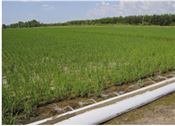Conserve Irrigation Water During Summer Months
STARKVILLE, MISS.
As temperatures rise and rainfall declines over the hot summer months, it is important to use our water resources efficiently.
Luckily, there are technologies and innovative strategies that farmers can employ to make every drop of water count.
In the Mississippi Delta, many farmers have turned to the Mississippi State University Extension Service Row-Crop Irrigation Science Extension and Research, or RISER, program to increase irrigation efficiency. In RISER, farmers use soil moisture sensors to develop irrigation schedules that meet the specific water requirements of their crops.
Next, farmers use surge valves to make sure the water reaches where plants need it, directing the right amount of water toward the rooting zone and reducing excess water runoff from the field. The third strategy is adopting computerized hole selection for polypipe used in furrow irrigation. This practice customizes how much and how fast water flows down each furrow.
Many irrigation efficiency strategies involve regrading the landscape to physically control water, using laser levels to flatten fields and make rainwater and irrigation spread evenly. Laser leveling can be used with a series of drain pipes to direct water runoff into ditches or ponds, where it can be held for use in future irrigations. Some Mississippi farmers are adopting these practices to recycle surface water rather than pump more groundwater.
Another technology, drip irrigation, allows water to drip slowly near plant roots, reducing the amount lost to evaporation. Subsurface drip irrigation applies water directly to the crop’s root zone using buried tubing referred to as dripline or drip tape. These two methods are more expensive than pivot irrigation or furrow irrigation, and they typically require more management. However, they have the potential to significantly reduce water use.
Improving soil health is an important part of water conservation. When soil is compacted, water may not be able to flow adequately to the root zone. Organic matter helps to maintain soil structure and to retain moisture longer. The U.S. Department of Agriculture reports that 1 percent of organic matter in the top 6 inches of soil will hold approximately 27,000 gallons of water per acre. This means healthy soils buffer crops from extreme environmental conditions, retaining more water during a drought and absorbing more water during heavy rains.
Strategies to improve soil conditions include reducing tillage and planting cover crops. Cover crops are grown in between cash crops to help boost soil health by increasing organic matter and reducing erosion. Conservation tillage, a practice in which farmers reduce tillage or stop tilling altogether, leaves crop residue from the previous season. In areas where compaction is common, using cover crops with reduced or no-till strategies can be beneficial.
Reducing water use can not only improve water availability for the future of farming, but also make farmers more profitable by reducing pumping expenses, improving soil health and boosting crop yields. ∆

Computerized hole selection provides furrow irrigation of rice
with water from a tailwater recovery system in the Mississippi Delta.
MSU Extension Service file photo